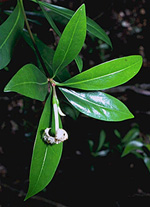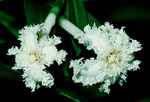 |
A very small family, Alseuosmiaceae occurs from New Guinea and New Caledonia to Australia and New Zealand. Two genera are found in Australia, Wittsteinia in eastern Victoria, and Crispiloba in north-east Queensland, both in wet sclerophyll forests or the margins of cool rain forests at high altitude.
Characteristic features of the family Alseuosmiaceae in Australia include: - shrubs with alternate, subopposite or apparently whorled leaves
- flowers urn- or salver-shaped, 5-partite
- ovary inferior, 2- to 3-locular
- fruit a berry
Description
Evergreen shrubs. Internal secretions not obvious. Plants glabrous or with simple, non-glandular, unicellular or uniseriate hairs. Leaves alternate and spiral or apparently whorled, in whorls of 3 or 4, petiolate. Stipules absent. Lamina simple, symmetric, elliptic, oblanceolate or obovate; base cuneate or attenuate; margins entire or serrate, ±flat; one-veined, or the venation pinnate, with the midrib conspicuous, and the tertiary venation not reticulate; surfaces not punctate; leathery. Plants with the flowers all bisexual. Inflorescences terminal, axillary, consisting of panicles, umbels or solitary flowers, or apparently of racemes or verticillasters. Bracts present or absent. Bracteoles present. Flowers fragrant, stalked. Floral disc present; nectaries present on the disc. Perianth regular, of 2 dissimilar whorls, valvate in bud. Calyx segments fused, with 5 lobes; calyx cup-shaped or bell-shaped, herbaceous. Corolla segments fused, with 5 lobes alternating with the calyx lobes; corolla urn-shaped or salver-shaped, white, cream, pink or green, membranous or papery; lobes ±entire or trifid, trilobed or more divided. Fertile stamens (4–) 5 (–7), opposite to the calyx lobes, free or at least partly fused to the corolla, free of the ovary and style, distinct from each other, all ±equal. Anthers dorsifixed, versatile, opening inwards by longitudinal slits; 2-celled. Ovary inferior. Carpels 2, free or fused; if fused, ovary with 2–3 locules. Style terminal or eccentric, single, unbranched and the fused stigma capitate. Ovules 2–5 per locule, sessile; placentation axile. Fruit a fleshy, indehiscent berry; the perianth on the maturing fruit deciduous or dry and persistent. Disseminule micro-surface ±smooth; greenish white, brown or black, dull. Seeds 2–12 per fruit. Aril absent. Cotyledons 2. Embryo straight or curved.
(Note: this description has been generated from the coded data compiled for the key. Any errors in the key data will be reflected in the descriptions.)
A treatment of the family Alseuosmiaceae has not yet been published in the Flora of Australia. It will appear in Volume 10.
Australian genera of Alseuosmiaceae (as recognised for the Flora of Australia)
Crispiloba
Wittsteinia

|
  |

Crispiloba disperma (flowering branch)
Photo: H.Nicholson © H. & N. Nicholson

Crispiloba disperma (flowers)
Photo: G.Sankowski © Zodiac Publications
|

| |